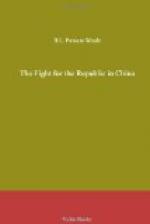What is the remedy? That must consist simply enough in attacking the grand simplicities directly; in recognizing, as we have clearly shown that the bases of Chinese life having collapsed through Euro-Japanese pressure, the politico-economic relationship between the Republic and the world must be remodelled at the earliest possible opportunity, every agreement which has been made since the Treaties of 1860 being carefully and completely revised. [Footnote: The mediaeval condition of Chinese trade taxation is well illustrated by a Memorandum which the reader will find in the appendix. One example may be quoted. Timber shipped from the Yalu river, i.e. from Chinese territory, to Peking, pays duties at five different places, the total amount of which aggregates 20 per cent of its market value; whilst timber from America, with transit dues and Peking Octroi added, only pays 10 per cent! China is probably the only country that has ever existed that discriminates against its own goods and gives preference to the foreigner,—through the operation of the Treaties.]
To say this is to give utterance to nothing very new or brilliant: it is the thought which has been present in every one’s mind for a number of years. So far back as 1902, when Great Britain negotiated with China the inoperative Mackay Commercial Treaty, provision was not only made for a complete reform of the Tariff— import duties to be made two and a half times as large in return for a complete abolition of likin or inter-provincial trade-taxation—but for the abolition of extraterritoriality when China should have erected a modern and efficient judicial system. And although matters equally important, such as the funding of all Chinese indemnities and loans into one Consolidated Debt, as well as the withdrawal of the right of foreign banks to make banknote issues in China, were not touched upon, the same principles would undoubtedly have been applied in these instances, as being conductive to the re-establishment of Chinese autonomy, had Chinese negotiators been clever enough to urge them as being of equal importance to the older issues. For it is primarily debt, and the manipulation of debt, which is the great enemy.
Three groups of indebtedness and three groups of restrictions, corresponding with the three vital periods in Chinese history, lie to-day like three great weights on the body of the Chinese giant. First, there is the imbroglio of the Japanese war of 1894-5; second, the settlement following the Boxer explosion of 1900; and third, the cost of the revolution of 1911-1912. We have already discussed so exhaustively the Boxer Settlement and the finance of the Revolutionary period that it is necessary to deal with the first period only.




